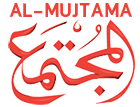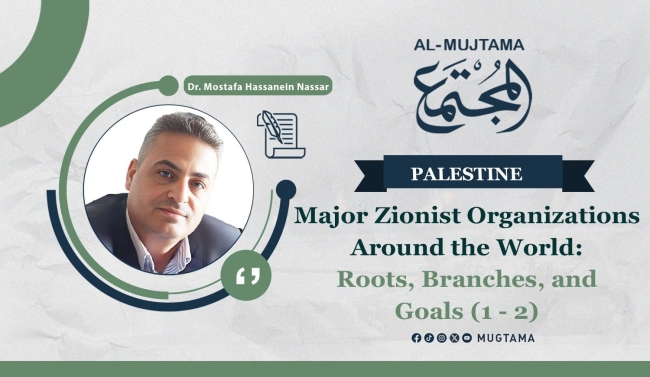We can perhaps say that no one in our country is free of suspicion and feelings of intense negativity towards the term "Zionism" and everything related to it. Nevertheless, there remains a need for more light to be shed on the roots of the Zionist movement, its branches, its objectives, its alliances, and its main centers of activity, etc.
First: The Roots of the Zionist Movement and Its Beginnings:
To begin with, the term "Zionism" is derived from the name "Zion," which is one of the names given to Mount Zion, considered to be the closest location to the alleged "Temple" in Jerusalem. In this context, the word "Zion" refers to the "Promised Land," emphasizing the necessity for all Jews from different corners of the world to return to it.
The derivation of the term with its meanings and political dimensions goes back to the Jewish thinker Nathan Birnbaum, who was the first to use it in this modern concept in an article he published in German in 1890, titled "Selbstmanzipation" (Self-Emancipation). He coined this term to distinguish the Zionist movement, which was merely an idea or call at that time, from another movement that emerged at the same stage with the same orientation, which was then known as the "Lovers of Zion.
The extended, complex, and entrenched Zionist movement was founded by a group of Jews led by Theodor Herzl, an Austrian Jewish journalist, during a conference they held in the Swiss city of Basel in 1897. Their most important declared goal was to establish a national homeland for the Jews in the land of Palestine and to return the Jews of the world to live under its protection!
It must be known that this movement, which has continued to this day, is the latest, most sustainable, intricate, and dangerous link in the series of attempts, movements, and coalitions throughout Jewish history. Among these are the attempts made by influential Jews in the West in modern times at earlier stages to establish the current movement. The most important of these movements include the following:
The "Shabtaist Levi" group appeared in the mid-18th century and was an extremely zealous Zionist movement, to the extent that its founder, Levi, claimed to be the awaited Messiah. However, it did not last long and did not achieve any of its goals.
There was a Zionist movement that emerged in Russia in the nineteenth century as well, but it did not gain much notoriety. This movement primarily focused on purchasing land in Palestine and establishing Jewish settlement communities on it, with the aim of relocating groups of Jews from Russia to live there, after the Jews faced massacres at the hands of the Russians.
In the second half of the 19th century, the famous Jewish Rothschild family established a movement called the "Jewish Money Men Movement," which was founded with the participation of some wealthy and influential Jews in Europe, most notably the well-known Jewish financier and businessman Montefiore. The movement created strong momentum for the situation of Jews in Europe and gave a tremendous boost to their aspirations in general, and their ambitions to seize Palestine to establish a national homeland for the Jews there in particular. The movement spent enormous amounts of money, even more than its predecessor, to purchase lands in Palestine and build Jewish settlements on them, aided by their deep-seated influence within European governments and decision-makers.
It is worth mentioning that the Rothschild family is known for its immense wealth and deep influence in Europe and its governments. They are the most famous European banking dynasty that has had a significant impact on economic history and, indirectly, on the political history of Europe for about 200 years.(1)
Zionism in its current form encompasses several variations and branches that emerged after its establishment. These include "political Zionism" and "practical Zionism," followed by "conciliatory Zionism," which sought to reconcile the various Zionist currents. In later stages, cultural, religious, democratic, labor, corrective, and radical Zionism emerged, each with its own orientation and style. However, there are no fundamental differences among them; they all share the same ultimate goal, which was also confirmed by Dr. Abdel Wahab El-Messiri, for example, in his encyclopedia.(2)
Secondly: The most important Zionist organizations around the world:
The Zionist organizations have multiplied and spread across various parts of the world, each with its specific role for which it was established. However, all of them come together and complement each other in a precise coordination to serve the "Israeli" entity and the Zionist goals in general. Since Zionism, due to its ambitions, seeks those who possess influence and power, it is natural for the most powerful and dangerous of these organizations to exist on the territory of the United States of America. Below are the most important and dangerous Zionist organizations in the world:
1- "The Zionist Organization" (the World Zionist Organization): is the first organizational structure that was established following the Basel Conference in 1897, chaired by Theodor Herzl, as we previously mentioned. It is essentially the effective practical translation of Zionist thought and the foundation upon which everything that followed was built. The organization continues to play an active role today, particularly in relation to supporting Zionist activities in Europe and coordinating between them, in addition to the significant role it plays with decision-making circles in major Western countries to serve the interests of the Zionist "Israeli" entity and Zionist activities in general.
2- "The Jewish Agency": In 1922, the Zionist Organization established the agency as an arm responsible for the practical tasks of Jewish settlement in the land of Palestine, including encouraging Jewish immigration to it, promoting, and organizing it, and providing the necessary facilities for its successive waves. This agency continues to carry out its activities, which have expanded in this context, through its offices scattered in several major countries.
3- "The American Israeli Public Affairs Committee" (AIPAC): It was established in the United States in 1959 and is considered one of the most important lobbying groups in the US in favor of the Zionist entity. This includes influencing American positions on the Palestinian issue in international forums, through their relationships with influential parties and key figures, especially members of Congress and candidates for the US presidency who always seek to win the votes of Jews and Zionists there. Additionally, the organization provides various forms of significant support to sway them and ensure their backing in return.
4- "Association of Reform Jews in America" (ARZA): One of the most important Zionist organizations operating in the United States since 1973, it is a gathering of what is known as "Reform Jews," and it exerts significant pressure on American decision-making circles to provide protection for the Zionist entity and defend its interests.
5- "The Zionist Women's Organization in America" (HADASSAH): The largest Zionist women's organization in the world, founded by prominent Zionist Henrietta Szold in 1912. Its primary activity focuses on spreading positive ideas about Jews to enhance their image in the eyes of Americans and others, in addition to many other activities dedicated to serving Zionists in general, especially their illegitimate entity.
____________________________________
Sources
- The New Encyclopedia Britannica, Encyclopedia Britannica, Inc., 15th ed, Chicago 1985.
- El-Messiri, Abdul Wahab: Encyclopedia of Jews, Judaism, and Zionism, Dar Al-Shorouk - Egypt, First Edition 1999, Volume Six, p. 15 and onwards.


